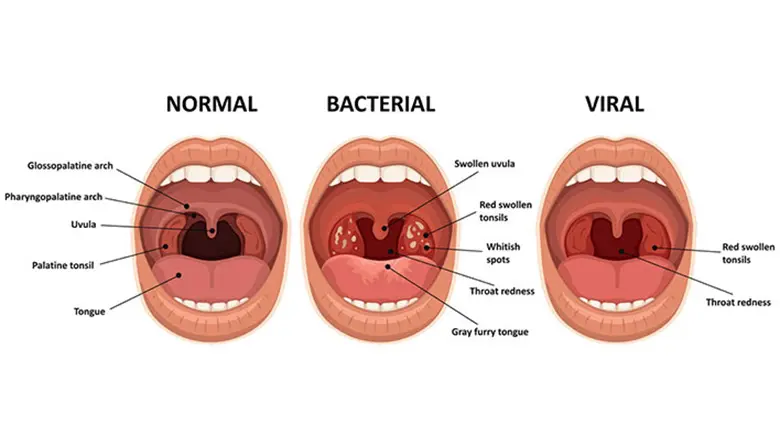What is a tonsillectomy?
Tonsillectomy is a surgery to remove the palatine tonsils from the top of your throat. This procedure is done to treat inflammation of the tonsils, also known as tonsillitis.
Tonsil removal is usually done for children. However, tonsillectomy in adults may still be needed for reasons such as:
- Frequent and persistent cases of sore throat
- Sleep apnoea caused by swollen tonsils blocking the airway
- Severe bad breath related to debris caught in the tonsils
- Cancer in the tonsil area
- Recurrent tonsil stones
What causes tonsillitis?

The tonsils form a part of our immune system and produce antibodies to fight pathogens (disease-causing germs) that enter the nose and mouth. Tonsillitis occurs when the tonsils become infected and enlarged.
There are 3 types of tonsillitis:
- Acute tonsillitis, which refers to the occasional tonsil infection
- Recurrent tonsillitis, which refers to recurring tonsil infections
- Chronic tonsillitis, which refers to a persistent baseline sore throat with acute flare-ups of tonsil infection
If you have an infected or inflamed tonsil, you may notice that your throat is red, and your tonsils are covered in a whitish or yellow coating.
You may also have chronic sleep apnoea related to enlarged tonsils or snoring that disrupts your sleep.
Why do you need a tonsillectomy?
Your doctor may recommend a tonsillectomy if you experience the following:
- Frequent, recurring episodes of tonsillitis
- Recurrent tonsil stones, which are often a sign of underlying chronic tonsil infection
- Pain on one side of the throat
- Sleep apnoea
- Breathing problems resulting from swollen or enlarged tonsils
- Bleeding on the tonsils
- Severe complications of tonsillitis such as neck abscess or quinsy (peritonsillar abscess)
The benefits of having a tonsillectomy include:
- Lowered risk of throat infections
- Reduced need for medication such as antibiotics
- Fewer medical visits
- Improved quality of life
What are the risks and complications of a tonsillectomy?
Tonsillectomy is a safe procedure with a low complication rate. However, like any other surgery, it carries some risks, such as:
- Reactions to anaesthesia. You may experience some minor short-term reactions to the medication, such as headache, nausea, vomiting or muscle soreness. Serious, long-term problems are rare. For general anaesthesia, this includes the risk of death.
- Swelling. You may experience swelling of the tongue and at the soft roof of your mouth (soft palate), particularly during the first few hours after the procedure. This can lead to breathing problems.
- Bleeding during surgery. In rare cases, there may be severe bleeding during surgery which requires additional treatment and a longer hospital stay.
- Bleeding during healing. You may experience some bleeding during the healing process, especially if the scab from the wound is dislodged too soon.
- Infection. In rare instances, surgery can lead to an infection that requires further treatment.
How do you prepare for a tonsillectomy?
The treatment for tonsillitis depends on the cause and severity of the condition.
Your doctor will ask you for information about the medications you are taking, your personal or family history of bleeding disorders, and any known drug allergies or adverse reactions to anaesthesia.
Prior to the tonsillectomy, you will receive instructions on how to prepare yourself for surgery, such as:
- Stopping some medications or changing the dosages of medications several days before the surgery
- Fasting after midnight before the scheduled surgery
- Making arrangements for transport home
- Planning for 10 – 14 days or more of recovery time
Before surgery, you may also be required to do:
- A sleep study (polysomnography) to treat obstructive sleep apnoea, obstructions of the airway or other related conditions
- A complete blood cell count to determine the cause of infection
- Certain blood tests
Depending on the results of your tests, your doctor will recommend the treatment that best suits you.
What can you expect in a tonsillectomy?
Tonsillectomy is usually done with an overnight stay in hospital but can also be undertaken as day surgery.
Reasons to stay overnight may include:
- Surgery for a young child
- Obstructive sleep apnoea
- Other complex health issues
Most patients stay overnight and return home the next day.
Before the procedure
Your doctor or another medical staff may go through a pre-surgery checklist of questions, such as an identity check and the reason for your surgery.
This is a standard procedure to ensure the safety of patients.
During the procedure
The surgeon will remove your tonsils by cutting them out with a scalpel, or with a specialised surgical tool that uses heat or ultrasound energy. This destroys soft tissues and stops bleeding.
As a tonsillectomy is performed under general anaesthesia, you will not be awake or experience pain during the procedure.
After the procedure
After a tonsillectomy, you may experience:
- Sore throat or throat pain, which is easily controlled with painkillers
- Occasional ear ache
- Bleeding, usually related to infection within the first 14 days after the operation
Care and recovery after tonsillectomy
Recovery time after a tonsillectomy can vary but most patients recover and are back to their normal routine and diet after about 7 – 10 days.
Adults tend to take longer to recover as compared to children.
Pain management is critical in your recovery from a tonsillectomy. To help relieve pain and promote healing, you may wish to:
- Avoid too much talking.
- Avoid smoking and alcohol.
- Drink plenty of fluids to stay hydrated.
- Eat only liquid food that is easy to swallow after surgery, such as porridge or soup. Gradually introduce soft food such as ice cream, before moving on to solid food. Avoid acidic, spicy, hard or crunchy food that may cause pain or bleeding.
- Resume normal activities but avoid vigorous high-intensity exercise for 2 weeks.
- Take prescribed medication, such as painkillers.
You should be able to return to work or school after:
- Resuming a normal diet
- Sleeping normally through the night
- Coming off your pain medication
Do have a discussion with your doctor about which activities you can do and which to avoid.







